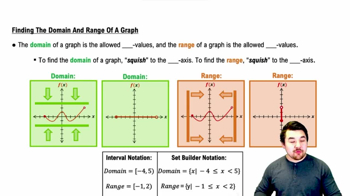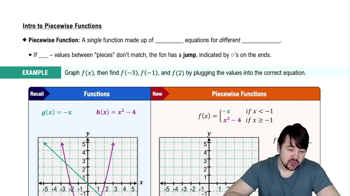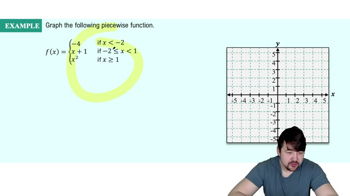Table of contents
- 0. Functions7h 52m
- Introduction to Functions16m
- Piecewise Functions10m
- Properties of Functions9m
- Common Functions1h 8m
- Transformations5m
- Combining Functions27m
- Exponent rules32m
- Exponential Functions28m
- Logarithmic Functions24m
- Properties of Logarithms34m
- Exponential & Logarithmic Equations35m
- Introduction to Trigonometric Functions38m
- Graphs of Trigonometric Functions44m
- Trigonometric Identities47m
- Inverse Trigonometric Functions48m
- 1. Limits and Continuity2h 2m
- 2. Intro to Derivatives1h 33m
- 3. Techniques of Differentiation3h 18m
- 4. Applications of Derivatives2h 38m
- 5. Graphical Applications of Derivatives6h 2m
- 6. Derivatives of Inverse, Exponential, & Logarithmic Functions2h 37m
- 7. Antiderivatives & Indefinite Integrals1h 26m
- 8. Definite Integrals4h 44m
- 9. Graphical Applications of Integrals2h 27m
- 10. Physics Applications of Integrals 2h 22m
0. Functions
Piecewise Functions
Problem 1.36
Textbook Question
In Exercises 35 and 36, find the (a) domain and (b) range.
𝔂 = { -x - 2, -2 ≤ x ≤ - 1
{ x, -1 < x ≤ 1
{ -x + 2, 1 < x ≤ 2
 Verified step by step guidance
Verified step by step guidance1
Step 1: Identify the piecewise function and its components. The function is defined as: y = -x - 2 for -2 ≤ x ≤ -1, y = x for -1 < x ≤ 1, and y = -x + 2 for 1 < x ≤ 2.
Step 2: Determine the domain of the function. The domain is the set of all x-values for which the function is defined. Here, the domain is the union of the intervals: [-2, -1], (-1, 1], and (1, 2].
Step 3: Analyze each piece of the function to find the range. For y = -x - 2, as x goes from -2 to -1, calculate the corresponding y-values. For y = x, as x goes from -1 to 1, calculate the y-values. For y = -x + 2, as x goes from 1 to 2, calculate the y-values.
Step 4: Combine the ranges from each piece to find the overall range of the function. Consider the y-values obtained from each interval and ensure there are no gaps.
Step 5: Verify the continuity and endpoints of the function. Check the values at the boundaries of each interval to ensure they are included in the range, and confirm that the function transitions smoothly between pieces where applicable.
 Verified video answer for a similar problem:
Verified video answer for a similar problem:This video solution was recommended by our tutors as helpful for the problem above
Video duration:
7mPlay a video:
Was this helpful?
Key Concepts
Here are the essential concepts you must grasp in order to answer the question correctly.
Domain
The domain of a function refers to the set of all possible input values (x-values) for which the function is defined. In this case, the function is piecewise defined, meaning it has different expressions for different intervals of x. To find the domain, we need to identify the intervals specified in the piecewise function and combine them to determine the overall set of x-values.
Recommended video:

Finding the Domain and Range of a Graph
Range
The range of a function is the set of all possible output values (y-values) that the function can produce based on its domain. For piecewise functions, we must evaluate each piece separately to find the corresponding y-values and then combine these results to determine the overall range. This often involves calculating the function's values at the endpoints of the intervals and any critical points within them.
Recommended video:

Finding the Domain and Range of a Graph
Piecewise Function
A piecewise function is defined by different expressions over different intervals of its domain. Each piece of the function applies to a specific range of x-values, and understanding how to analyze each segment is crucial for determining the overall behavior of the function. In this question, the function is defined in three segments, each with its own formula and domain restrictions.
Recommended video:

Piecewise Functions
Related Videos
Related Practice




